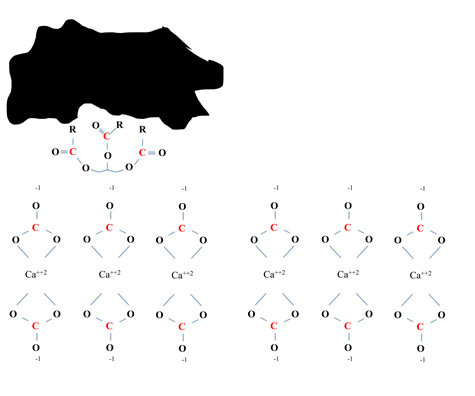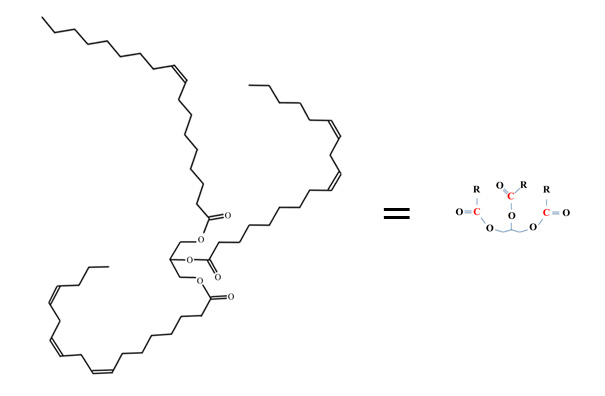Lithography

Limestone mit "Greasy" Drawing
Once your stone is grained, you need to make the drawing with a "greasy" medium. This can be a "greasy" crayon or "greasy' ink or a "greasy" pencil. The pigment isn't that important at this stage except it allows you to see the image.
The word "greasy" in lithography is a fairly specialized term. It means not only using an oil based drawing medium, but using a medium based on vegetable oils or waxes or animal fat. They cannot be petroleum based, the so-called mineral oils or spirits. You need vegetable oils or animal fats because they 1) have low water solubility (as do mineral oils) and 2) can react with acid and water (which petroleum oils or waxes don't),
To show what we mean, in the highly schematic representation above, the black blob represents (of course) the pigment particle. The structure below the pigment is the vegetable oil.
The picture shown below, on the other hand, is a more literal representation of a vegetable oil or animal fat molecule, a class of compounds called triglycerides. Yes. Animal fats - so often touted as bad! bad! bad! for your health are chemical the same as healthful canola oil. The only differ in the number of hydrogens - that is the amount of saturation or unsaturation in the chains. So for now we'll just assume our oil is vegetable oil.

Vegetable Oil Molecule
The long chains made up of the carbon and hydrogen atoms are what makes oils oily. On the other hand, the oxygen atoms are attached to both the fatty acid group (actually a fatty ester) and the glycerin part in the center. Glycerin, without the fatty acid groups attached, is completely water soluble. On the whole, though, vegetable oils are virtually insoluble in water and mix well with other oils.
For simplicity we have and in subsequent slides represented the vegetable oil in the more compact manner following usual conventions of organic chemistry textbooks where the long chains are simply represented by an R. That is:

Simplified Vegetable Oil Molecule
The point to remember is that because the limestone is made up of calcium's positive ions and carbonate's negative ions, the limestone surface likes water (for the same reason table salt - sodium and chloride ions - likes water). The vegetable oil does not like water as all know who have had kitchen grease plug a sink.
But triglycerides are strange molecules. Although they don't like water - that is they don't dissolve it in any degree - water will move to the center part around the oxygens. Not much, but enough to react with it. So the next step is to add water to the stone. We will do that if you click here.